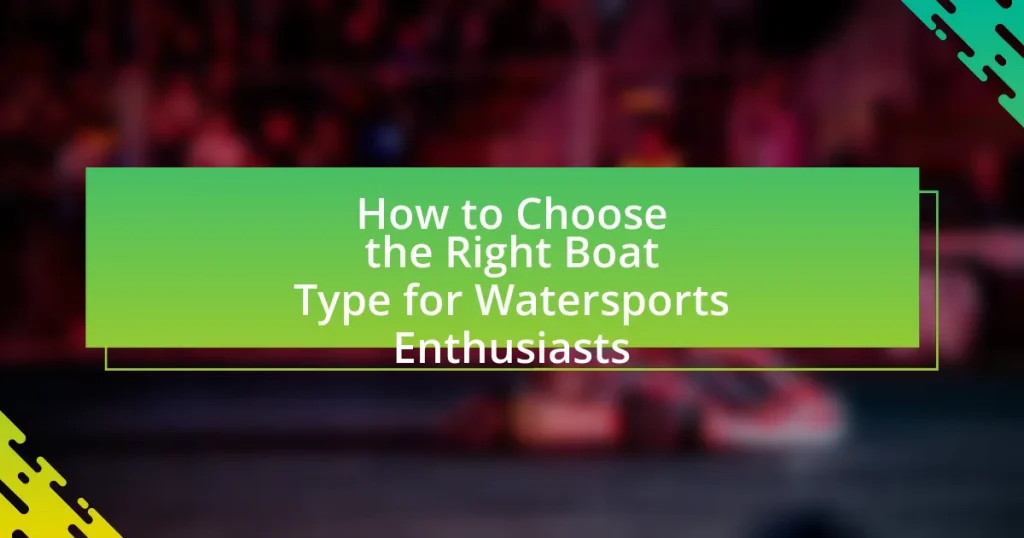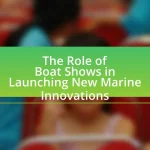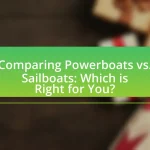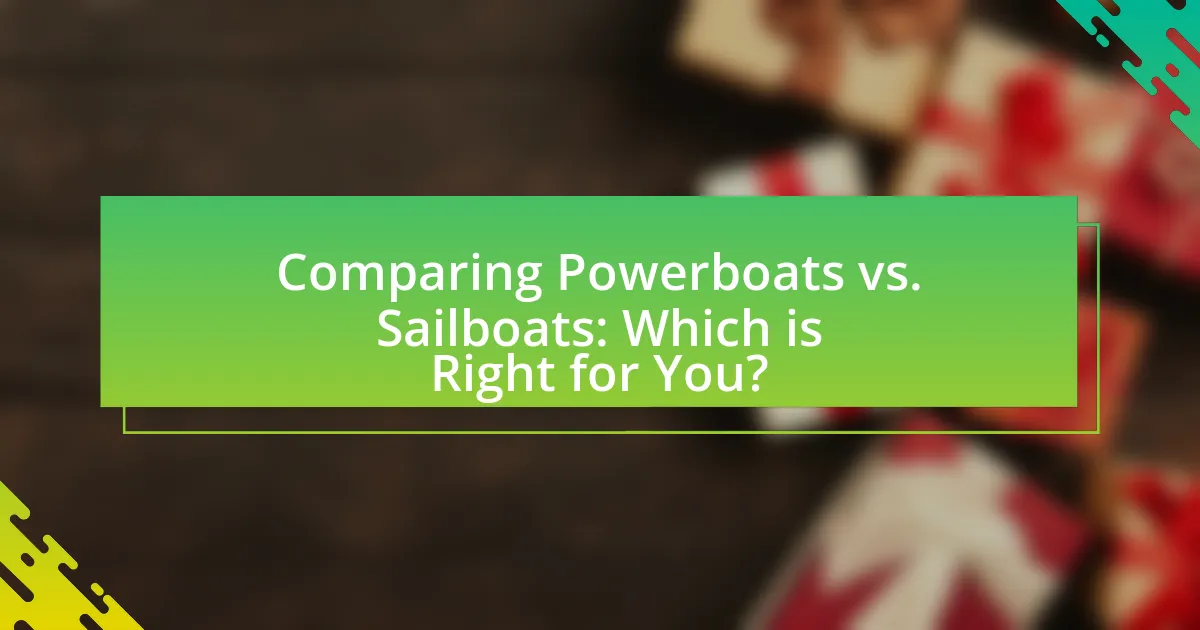The article focuses on how to choose the right boat type for watersports enthusiasts, emphasizing key factors such as intended activities, boat size, and engine power. It outlines how different watersports, including wakeboarding and water skiing, influence boat selection, detailing specific requirements for various boat types like wakeboard boats, speedboats, and pontoon boats. The article also discusses the advantages and disadvantages of each boat type, budget considerations, and essential features to look for in terms of comfort and safety. Additionally, it highlights common mistakes to avoid and the importance of maintenance and storage options in ensuring a satisfactory boating experience.
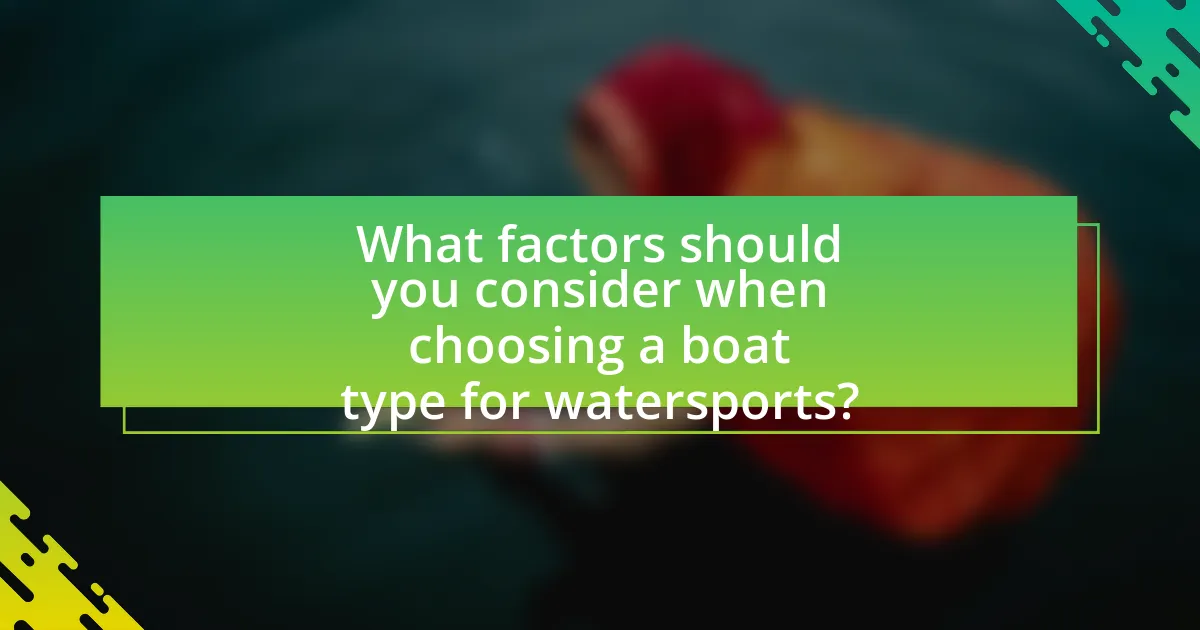
What factors should you consider when choosing a boat type for watersports?
When choosing a boat type for watersports, consider the intended activity, boat size, and engine power. The intended activity, such as wakeboarding, skiing, or tubing, dictates the boat’s design and features; for example, a wakeboard boat typically has a specialized hull for creating a larger wake. Boat size is crucial as it affects stability and capacity; larger boats can accommodate more passengers and gear, enhancing the experience. Engine power is also vital; boats with higher horsepower can achieve the necessary speeds for various watersports, ensuring safety and performance. These factors collectively influence the suitability of a boat for specific watersport activities.
How do different watersports influence your boat selection?
Different watersports significantly influence boat selection by dictating the design, size, and performance characteristics required for optimal activity. For instance, wakeboarding necessitates a boat with a powerful engine and a hull designed to create a large wake, while fishing boats prioritize stability and storage for gear. Additionally, sailing requires a vessel with a suitable sail plan and rigging, whereas jet skiing demands lightweight, high-speed craft. Each watersport’s unique requirements lead to specific boat features, such as hull shape, engine type, and capacity, ensuring that the selected boat enhances the overall experience and performance in that sport.
What are the specific requirements for wakeboarding boats?
Wakeboarding boats must have specific requirements to optimize performance and safety. These boats typically feature a powerful engine, often between 300 to 500 horsepower, to create sufficient speed and wake. Additionally, they should have a hull design that enhances wake shape, such as a V-shaped or modified V-hull, which allows for better control and stability.
Furthermore, wakeboarding boats are equipped with ballast systems to adjust the weight distribution, enhancing the size and shape of the wake. A tower or pylon is also essential for towing, as it provides a higher pull point, reducing drag and improving rider experience.
Safety features, including non-slip surfaces, grab handles, and adequate storage for gear, are also critical. These specifications ensure that wakeboarding boats meet the demands of the sport while providing a safe environment for riders.
How does the choice of boat affect performance in water skiing?
The choice of boat significantly affects performance in water skiing by influencing speed, stability, and wake shape. A boat designed specifically for water sports, such as a ski boat, typically features a powerful engine and a hull shape that creates a clean, consistent wake, which is essential for optimal skiing conditions. For instance, boats with a V-shaped hull can produce a smoother wake, allowing skiers to achieve better control and maneuverability. Additionally, the weight and ballast of the boat can be adjusted to enhance stability and improve the overall skiing experience. Research indicates that boats with proper weight distribution can reduce drag and enhance acceleration, leading to improved performance for skiers.
What are the key characteristics of various boat types?
The key characteristics of various boat types include their design, purpose, and performance capabilities. For instance, speedboats are designed for high-speed travel and agility, making them ideal for watersports like wakeboarding and water skiing. Sailboats, characterized by their reliance on wind for propulsion, offer a different experience, focusing on leisure and exploration. Pontoon boats, with their flat deck and stability, are perfect for family outings and social gatherings on the water. Fishing boats, often equipped with specialized gear, prioritize functionality and storage for anglers. Each boat type serves distinct purposes, influencing the choice for watersports enthusiasts based on their specific activities and preferences.
What distinguishes a jet ski from a traditional boat for watersports?
A jet ski is distinguished from a traditional boat for watersports primarily by its design and maneuverability. Jet skis are smaller, personal watercraft that allow for quick acceleration and sharp turns, making them ideal for activities like racing and tricks. In contrast, traditional boats are larger, often designed for stability and carrying multiple passengers, which can limit their agility in the water. The jet ski’s lightweight structure and direct steering control enable a more dynamic experience, while traditional boats typically require more space and time to navigate.
How do pontoon boats compare to speedboats for watersports activities?
Pontoon boats are generally less suitable for watersports activities compared to speedboats. Speedboats are designed for high speeds and agility, making them ideal for activities like wakeboarding, waterskiing, and tubing, where quick acceleration and maneuverability are essential. In contrast, pontoon boats prioritize stability and space, which can limit their performance in fast-paced watersports. For example, speedboats can reach speeds of 30 to 50 mph, while pontoon boats typically operate at slower speeds, around 15 to 25 mph, making them less effective for towing activities.
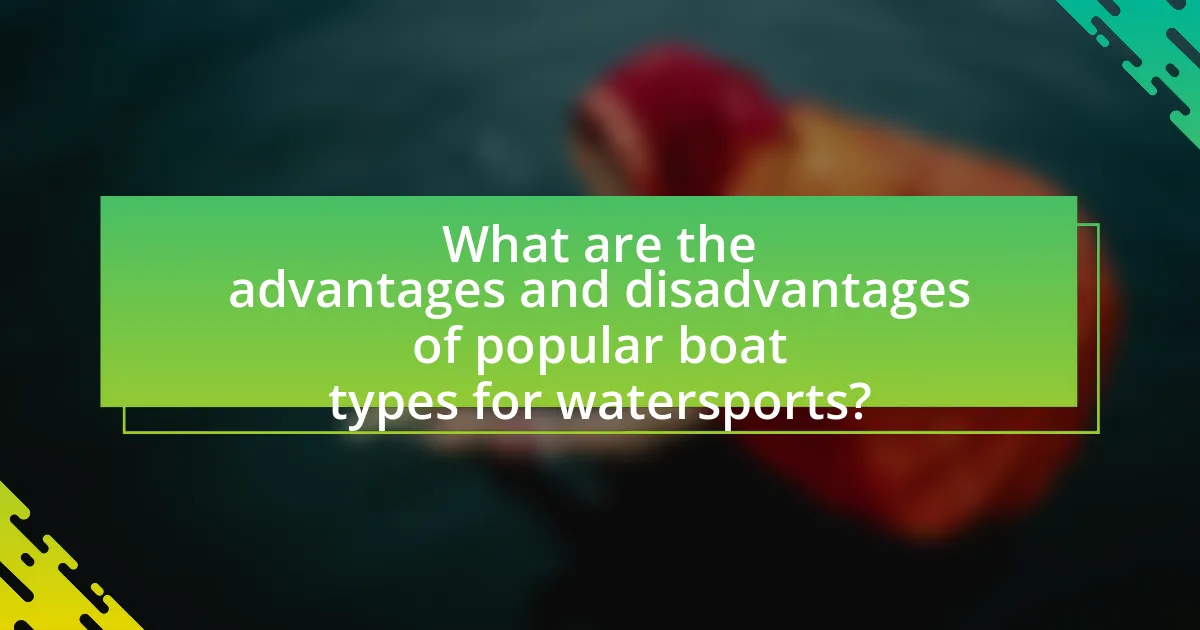
What are the advantages and disadvantages of popular boat types for watersports?
Popular boat types for watersports include jet skis, wakeboard boats, and pontoon boats, each with distinct advantages and disadvantages. Jet skis offer high speed and maneuverability, making them ideal for thrill-seekers; however, they have limited passenger capacity and can be less stable in rough waters. Wakeboard boats are designed for towing and provide a stable platform for wakeboarding, but they can be expensive and require more maintenance. Pontoon boats are spacious and great for leisurely activities, accommodating larger groups, yet they are generally slower and less suitable for high-speed watersports. Each boat type serves different needs, influencing the choice based on the specific watersport activity desired.
What are the benefits of using a speedboat for watersports?
Using a speedboat for watersports offers several benefits, including high speed, agility, and versatility. Speedboats can reach speeds of up to 70 mph, allowing for thrilling activities such as wakeboarding, waterskiing, and tubing. Their design enables quick maneuverability, making it easier to navigate tight turns and perform tricks. Additionally, speedboats often come equipped with powerful engines and specialized features like wake-enhancing hulls, which improve the overall experience for participants. These advantages make speedboats a popular choice among watersports enthusiasts seeking excitement and performance on the water.
How does a speedboat enhance the experience of watersports enthusiasts?
A speedboat enhances the experience of watersports enthusiasts by providing high speeds and agility, which are essential for activities like wakeboarding, waterskiing, and tubing. The powerful engines of speedboats allow for quick acceleration and the ability to create large wakes, enhancing the thrill and excitement of these sports. Additionally, speedboats are designed for maneuverability, enabling sharp turns and quick stops, which are crucial for performing tricks and stunts. This combination of speed and control significantly elevates the overall enjoyment and performance of watersports activities.
What limitations should you be aware of when using a speedboat?
When using a speedboat, limitations include fuel consumption, maintenance costs, and restricted access to shallow waters. Speedboats typically consume more fuel than other types of boats, which can lead to higher operational costs, especially during long outings. Additionally, speedboats require regular maintenance to ensure optimal performance, which can be expensive and time-consuming. Furthermore, their design often limits access to shallow areas, making it difficult to navigate in certain environments, such as rivers or coastal regions with low tides. These factors should be carefully considered by watersports enthusiasts when choosing a speedboat.
Why might a pontoon boat be a good choice for family watersports?
A pontoon boat is a good choice for family watersports due to its stability and spacious design. The wide, flat platform of a pontoon boat provides a safe environment for families, reducing the risk of capsizing, which is particularly important when engaging in activities like tubing or wakeboarding. Additionally, the ample deck space allows for multiple family members to participate in watersports simultaneously, enhancing the overall experience. According to the National Marine Manufacturers Association, pontoon boats are among the most popular types of recreational boats, indicating their suitability for family-oriented activities on the water.
What features make pontoon boats suitable for group activities?
Pontoon boats are suitable for group activities due to their spacious design, stability, and versatility. The wide deck space allows for multiple people to comfortably gather, making them ideal for socializing, dining, or engaging in recreational activities. Their flat, stable platform minimizes the risk of tipping, which enhances safety for larger groups. Additionally, many pontoon boats come equipped with amenities such as seating arrangements, sun shades, and storage compartments, further accommodating group needs. These features collectively support a variety of activities, from fishing to parties, making pontoon boats a popular choice for group outings on the water.
What are the downsides of using a pontoon boat for high-speed watersports?
Pontoon boats are generally not suitable for high-speed watersports due to their design, which prioritizes stability and space over speed and agility. Their flat-bottomed hulls create significant drag, limiting their ability to reach high speeds compared to traditional ski boats or wakeboard boats, which are specifically engineered for performance. Additionally, pontoon boats often lack the necessary power-to-weight ratio, as they typically use lower horsepower engines, further hindering their capability for high-speed activities. This combination of design and performance limitations makes pontoon boats less effective for watersports that require quick acceleration and sharp maneuverability.
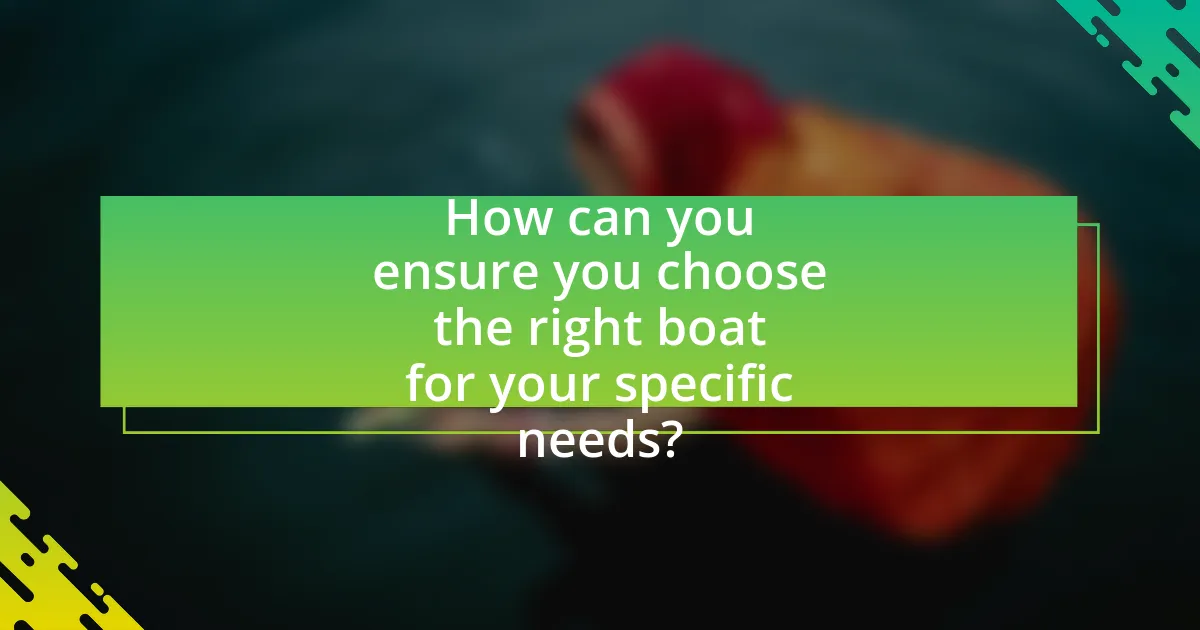
How can you ensure you choose the right boat for your specific needs?
To ensure you choose the right boat for your specific needs, first assess your intended use, such as fishing, skiing, or cruising. Different activities require different boat types; for example, a ski boat is designed for speed and agility, while a fishing boat offers stability and storage for gear. Additionally, consider factors like the number of passengers, storage capacity, and the type of water conditions you will encounter. Research indicates that selecting a boat that aligns with your primary activities increases satisfaction and safety, as noted in the National Marine Manufacturers Association reports, which highlight that 70% of boaters are more satisfied when their boat meets their specific recreational needs.
What questions should you ask yourself before purchasing a boat?
Before purchasing a boat, you should ask yourself several key questions: What type of watersports do I intend to engage in? Understanding the specific activities, such as wakeboarding, skiing, or fishing, will help determine the appropriate boat type. How often will I use the boat? Frequent use may justify a higher investment in quality and features. What is my budget for the purchase and ongoing maintenance? Establishing a clear financial plan is crucial for sustainable ownership. Where will I store the boat? Adequate storage space is necessary to protect the investment. Lastly, do I have the necessary skills and licenses to operate the boat safely? Ensuring compliance with local regulations and personal capability is essential for safe enjoyment.
How do your skill level and experience affect your boat choice?
Your skill level and experience significantly influence your boat choice by determining the type of vessel that matches your abilities and comfort level. Beginners typically require more stable and user-friendly boats, such as pontoons or bowriders, which offer ease of handling and safety features. In contrast, experienced boaters may opt for high-performance vessels like wakeboard boats or jet skis, which demand advanced skills for optimal operation. Research indicates that 70% of novice boaters prefer boats with lower horsepower and simpler controls, while seasoned enthusiasts often seek out specialized equipment that enhances performance and maneuverability. This correlation between skill level and boat type ensures that individuals select vessels that align with their capabilities, enhancing both safety and enjoyment on the water.
What budget considerations should you keep in mind when selecting a boat?
When selecting a boat, key budget considerations include the purchase price, maintenance costs, insurance, fuel expenses, and storage fees. The purchase price varies significantly based on the type and size of the boat, with new boats typically costing more than used ones. Maintenance costs can average 10% of the boat’s value annually, covering repairs and routine upkeep. Insurance premiums depend on the boat’s value and usage, while fuel expenses fluctuate based on engine type and usage frequency. Additionally, storage fees for dockage or winterization can add to the overall budget. Understanding these factors ensures a comprehensive financial plan for boat ownership.
What are some tips for testing a boat before making a decision?
To effectively test a boat before making a decision, conduct a thorough on-water trial to assess performance, handling, and comfort. During the trial, evaluate the boat’s acceleration, turning radius, and stability in various conditions, as these factors significantly impact the overall experience for watersports enthusiasts. Additionally, inspect the boat’s features, such as storage capacity and seating arrangements, to ensure they meet your specific needs. According to the National Marine Manufacturers Association, a proper test drive can reveal potential issues and help confirm that the boat aligns with your intended use, making it a crucial step in the purchasing process.
How can you evaluate a boat’s performance during a test drive?
To evaluate a boat’s performance during a test drive, assess key factors such as acceleration, handling, stability, and fuel efficiency. Acceleration can be measured by how quickly the boat reaches its top speed from a standstill, indicating engine power and responsiveness. Handling involves testing the boat’s maneuverability, particularly during sharp turns and at various speeds, which reflects its design and hull shape. Stability can be observed by how well the boat maintains balance in choppy waters, essential for safety and comfort. Fuel efficiency can be evaluated by monitoring fuel consumption over a set distance, providing insight into operational costs. These performance metrics are critical for watersports enthusiasts, as they directly impact the enjoyment and safety of activities on the water.
What should you look for in terms of comfort and safety features?
When selecting a boat for watersports, prioritize comfort features such as ergonomic seating, ample storage, and climate control systems. Ergonomic seating supports prolonged use, while sufficient storage allows for gear organization, enhancing the overall experience. Additionally, safety features like life jackets, non-slip surfaces, and reliable navigation systems are crucial. Life jackets are essential for compliance with safety regulations, non-slip surfaces prevent accidents, and navigation systems ensure safe travel on water. These elements collectively enhance both comfort and safety, making them vital considerations for watersports enthusiasts.
What common mistakes should you avoid when choosing a boat for watersports?
When choosing a boat for watersports, avoid underestimating the importance of the boat’s power and capacity. Selecting a boat with insufficient horsepower can lead to poor performance during activities like wakeboarding or waterskiing, as these sports require adequate thrust for optimal speed and maneuverability. Additionally, neglecting to consider the boat’s weight capacity can result in safety hazards, as exceeding this limit can compromise stability and control on the water. Furthermore, failing to assess the boat’s design for specific watersports can lead to an uncomfortable experience; for instance, a boat not designed for towing may struggle to pull skiers effectively. Lastly, overlooking the need for proper safety features, such as life jackets and emergency equipment, can pose significant risks during watersport activities.
How can overestimating your needs lead to poor boat selection?
Overestimating your needs can lead to poor boat selection by causing individuals to choose larger, more expensive, or less suitable boats that do not align with their actual usage requirements. For instance, a watersports enthusiast may believe they need a high-performance boat for casual outings, resulting in the purchase of a vessel that is difficult to handle and maintain. This misjudgment can lead to increased costs, both in terms of purchase price and ongoing expenses such as fuel and maintenance. Additionally, selecting a boat that exceeds one’s actual needs can result in a lack of enjoyment and usability, as the individual may struggle with the boat’s size or complexity.
What are the risks of not considering maintenance and storage options?
Not considering maintenance and storage options poses significant risks, including increased costs, reduced lifespan of the boat, and potential safety hazards. Without regular maintenance, boats can suffer from mechanical failures, leading to costly repairs and downtime. Additionally, improper storage can result in damage from environmental factors such as moisture, which can cause mold and corrosion. According to the National Marine Manufacturers Association, neglecting maintenance can decrease a boat’s resale value by up to 30%. Therefore, prioritizing maintenance and storage is essential for ensuring the longevity and safety of the vessel.
